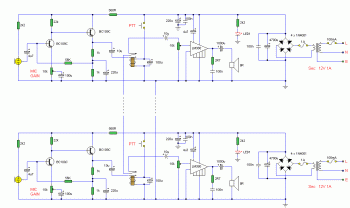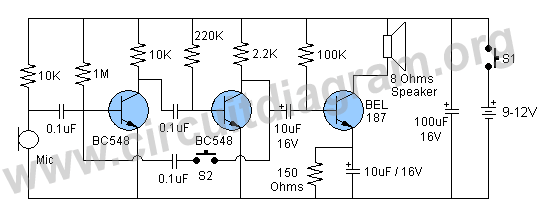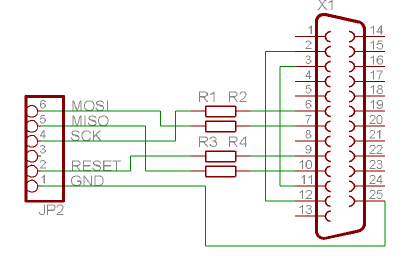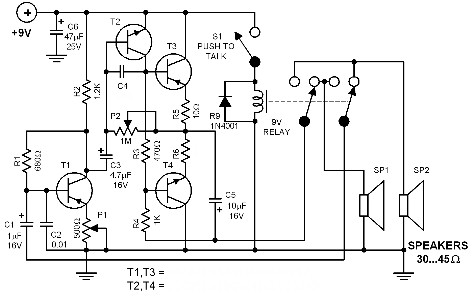
Simplest Intercom
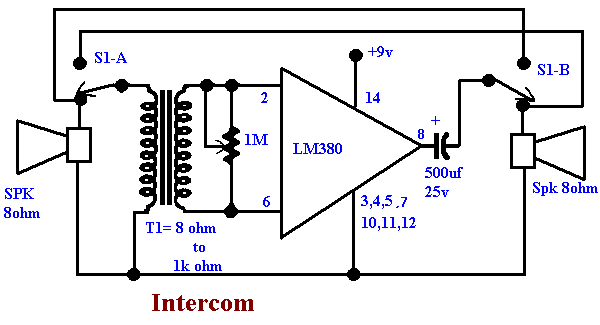
This circuit was requested by a school teacher. It is a simple intercom that anyone can assemble and operate. It is based on the LM380 integrated circuit (IC).
The intercom circuit utilizing the LM380 IC is designed for straightforward assembly and functionality, making it suitable for educational purposes. The LM380 is a power amplifier capable of delivering up to 14 watts of output power, making it ideal for audio applications such as intercoms.
The circuit typically consists of a microphone, the LM380 IC, a speaker, and supporting passive components like resistors and capacitors. The microphone captures audio signals, which are then fed into the LM380. The IC amplifies these signals, which are subsequently output through a speaker, allowing for clear audio communication.
Key components include:
1. **Microphone**: Converts sound waves into electrical signals.
2. **LM380 IC**: Acts as the main amplifier; it requires a power supply, typically between 14V to 35V, to function effectively.
3. **Speaker**: Converts the amplified electrical signals back into sound.
4. **Resistors and Capacitors**: These components are used for biasing, gain control, and filtering to ensure optimal performance of the circuit.
The circuit design should also include proper power supply decoupling to minimize noise and ensure stable operation. Additionally, it is advisable to incorporate a volume control mechanism, which can be achieved using a potentiometer connected to the input of the LM380.
Overall, this intercom circuit is an excellent educational project, demonstrating basic principles of audio amplification and circuit design. It provides a practical application for students to learn about electronics while creating a functional communication device.This circuit was requested by an school teacher. It is a simple intercom that anyone can put together and get to work. It is based on the LM380 IC chip. T.. 🔗 External reference
The intercom circuit utilizing the LM380 IC is designed for straightforward assembly and functionality, making it suitable for educational purposes. The LM380 is a power amplifier capable of delivering up to 14 watts of output power, making it ideal for audio applications such as intercoms.
The circuit typically consists of a microphone, the LM380 IC, a speaker, and supporting passive components like resistors and capacitors. The microphone captures audio signals, which are then fed into the LM380. The IC amplifies these signals, which are subsequently output through a speaker, allowing for clear audio communication.
Key components include:
1. **Microphone**: Converts sound waves into electrical signals.
2. **LM380 IC**: Acts as the main amplifier; it requires a power supply, typically between 14V to 35V, to function effectively.
3. **Speaker**: Converts the amplified electrical signals back into sound.
4. **Resistors and Capacitors**: These components are used for biasing, gain control, and filtering to ensure optimal performance of the circuit.
The circuit design should also include proper power supply decoupling to minimize noise and ensure stable operation. Additionally, it is advisable to incorporate a volume control mechanism, which can be achieved using a potentiometer connected to the input of the LM380.
Overall, this intercom circuit is an excellent educational project, demonstrating basic principles of audio amplification and circuit design. It provides a practical application for students to learn about electronics while creating a functional communication device.This circuit was requested by an school teacher. It is a simple intercom that anyone can put together and get to work. It is based on the LM380 IC chip. T.. 🔗 External reference
Warning: include(partials/cookie-banner.php): Failed to open stream: Permission denied in /var/www/html/nextgr/view-circuit.php on line 713
Warning: include(): Failed opening 'partials/cookie-banner.php' for inclusion (include_path='.:/usr/share/php') in /var/www/html/nextgr/view-circuit.php on line 713

